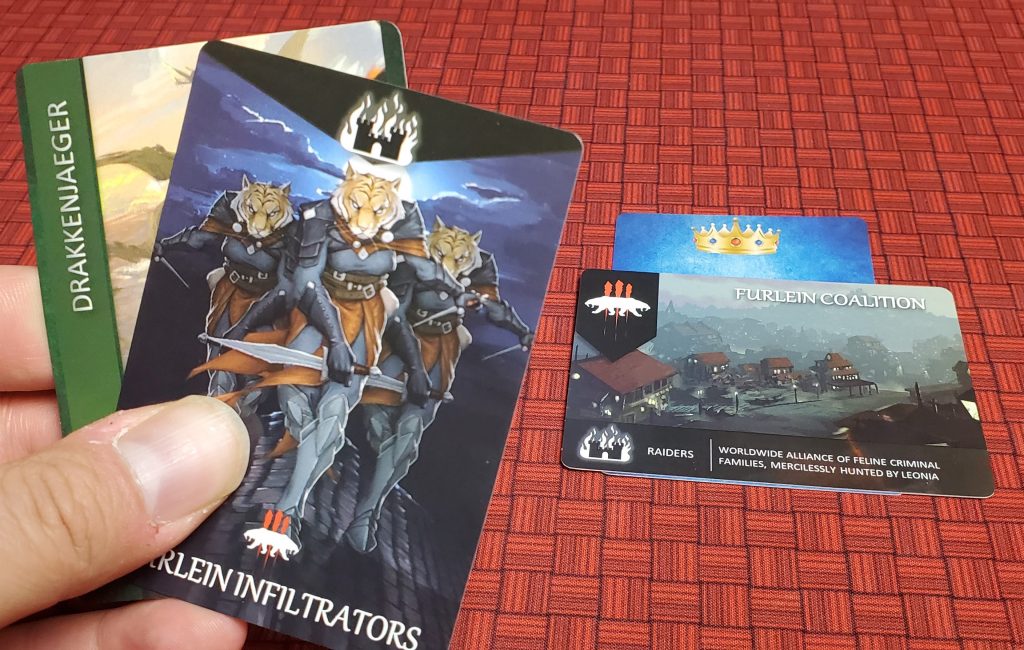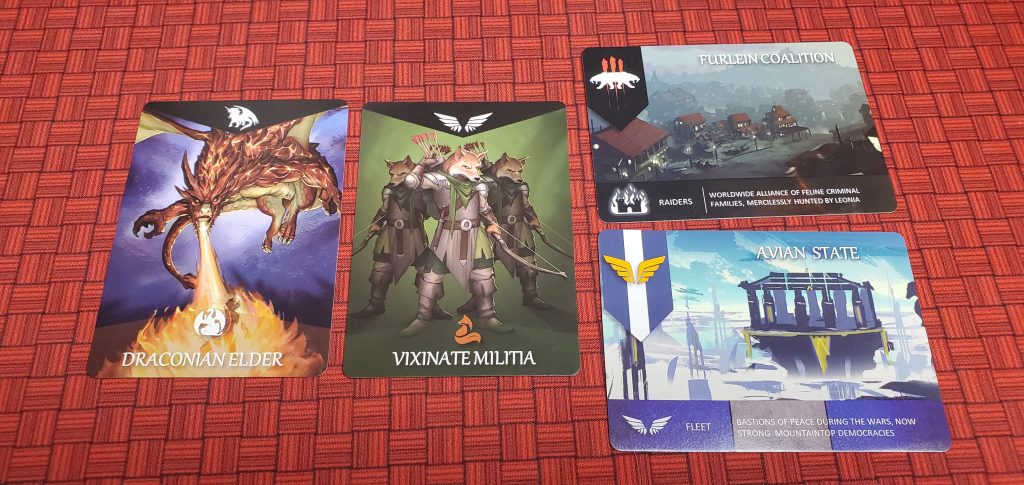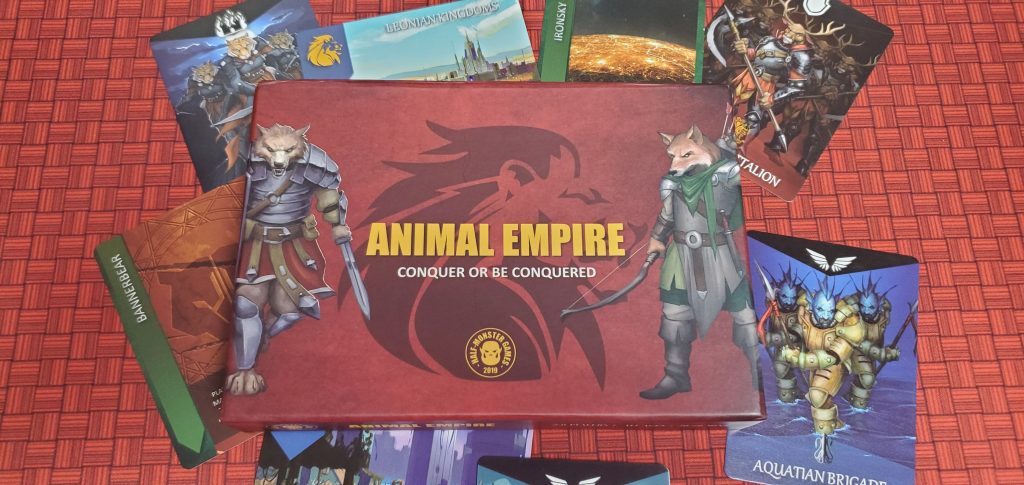In Animal Empire – a 2-8 player card game from Half-Monster Games – the world’s animals gained sentience long ago and overthrew the world-destroying Magnon civilization. You take on the role of a Monarch of a specific animal… well, kingdom, trying to forge an empire over all other sentient animals and save your own species from extinction.
Rise of the Animals

The game starts with each player getting one Army card, the corresponding Kingdom card for that Army, one Wilderness card, and one Crown card in a color of their choosing. The Crown card is placed behind the Kingdom card, with the crown and color showing above the Kingdom card. The remaining Kingdom cards are laid out in the middle of the table, face-down, and the remaining Army and Wilderness cards are in their own face-down decks, available to all players. The goal is to claim control over a majority of the 16 Kingdoms (9 in total), either directly in your control or through your Vassals.
On a player’s turn, they can perform up to 2 actions, with each Army under their control able to perform one action each. So until a player gains another Army, they are actually limited to a single action at the beginning of the game. The actions are March (place the Army on any Kingdom card), Capture (claim the Kingdom on which the Army is located if there is no opposition, or you outnumber your opponent’s Armies), Battle (if an opponent’s Army is on the same Kingdom card, this will force it back into their owner’s hand), Seize Crown (if the Kingdom has a Crown card, you may claim this instead, which will make that player your Vassal), Manage Vassal (either give or take a kingdom from them).
Each of the Armies will also have a Specialty, which are abilities that activate under certain circumstances. The Attacker trait allows you to immediately force an enemy Army to retreat to its owner’s hand when the Attacker moves into a kingdom, unless the enemy Army has Defender. The Defender trait simply means that the Army cannot be affected by the Attacker trait, although it can still be forced to retreat during regular combat. And so on…
Kingdoms (and their corresponding Armies) are claimed by Marching your army to the Kingdom, then Capturing it on a subsequent turn. Armies can also March to the Wilderness deck, which will allow you to draw the top card and place it, along with the marching Army, in your hand. The Wilderness cards allow players to perform additional actions, or modify other cards already in play (e.g., the ‘Bannerbear’ card can be played at any time to allow you to immediately March up to 2 of your armies to a Kingdom you already have an Army on, instantly reinforcing it, and the ‘Ironsky Generator,’ when played, will give any army that is not a Defender the Defender trait until the end of your next turn).
Something that was touched on before is ‘Vassals’. Once a player’s Crown card is Captured by another player, the original owner of the Crown card becomes a Vassal to the capturing player. That means that they are kind of a forced team, and the now-owner of the Crown card can give orders to their Vassal, and they win (or lose) as a team, but the ruling Emperor will get the ultimate victory.
The Ides of Marching
We’ve played this game several times at different player counts, and although we found that 2-player is our least favorite (even starting with 2 Kingdoms each, per the rules), we found it hard to capture kingdoms simply because having to wait a turn after moving into a kingdom to actually capture it always gave other players the ability to just march armies back into it, keeping players from capturing, which too often led to a see-saw over a specific kingdom. This brought up too many instances of the game grinding to a halt while an army was marched to a kingdom, then another army was marched there to counter it, rinse and repeat, until someone just gave up and said, “You can have it.” And you almost always have to respond directly to a marching army, since once someone gets ahead in kingdoms/armies, they have a huge advantage in being able to leave armies on several kingdoms over several turns and capture them at their leisure.
The Vassal idea is interesting, in that as an Emperor, you can give orders to your Vassals, which they can then choose to carry out or ignore altogether. The orders have to be general in nature, such as “Attack that Empire,” or “Defend me.” This is where the Manage Vassal action can help or hinder you. Do you punish a Vassal who doesn’t follow orders by taking one of their kingdoms, thereby making their own little Empire weaker? Or look the other way, since if they are able to contribute, there is a better chance of you winning the game, but would encourage their further disobedience and possible revolution?
Beautiful Plumage
This is a small-box game, with a grand total of 56 cards. And the artwork on the cards is outstanding. Barend Chamberlain, Craig Lee, and Jess Wilce really impressed with their landscape art, character portraits, and event images. The downside is that on most of the Army cards, the impressive artwork is countered by the fact that the multiple soldiers on each card are simply cut-and-pasted (sometimes mirrored) from the original, which lends an air of cheapness.

Fall of the Animals
While the game has some interesting ideas, it ultimately falls a little flat due to the monotony of the midgame, although this is worst at 2-players. The artwork is gorgeous, but can’t save this Kingdom from falling.
If you’re looking for a light-weight, quick, area-control game, and have a group of at least 3 players (recommend 5+), give this game a look, but if you’re primarily a 2-player group, we cannot recommend this Animal Empire.
